|
This Arbor Day, we’re celebrating the important role that trees play in fighting climate change and getting to net zero carbon emissions, which is the county’s new greenhouse gas emission reduction goal. Net zero carbon emissions is achieved by “balancing” a limited amount of carbon released with offsets that remove carbon from the atmosphere.
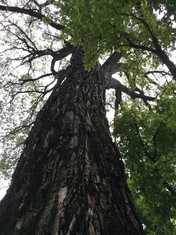
Trees remove carbon dioxide from the atmosphere through photosynthesis and store carbon in their wood. The older the tree, the more climate benefits it provides. The shade from trees also lessens the need for cooling in buildings, which reduces carbon dioxide and other pollutants from power plants.
For example, an oak tree with a 20 inch diameter – big enough that an adult could barely wrap their arms around – reduces carbon in the atmosphere by about 1,000 pounds annually. That’s enough to charge your smartphone about 55,000 times!
Trees provide many additional benefits. That same tree near a single-family home provides overall benefits of about $200 per year by increasing the property value, conserving electricity, intercepting and filtering stormwater, and improving air quality. Imagine the benefits multiplying for each tree in your neighborhood!
|
The benefits of a 20-inch diameter oak tree
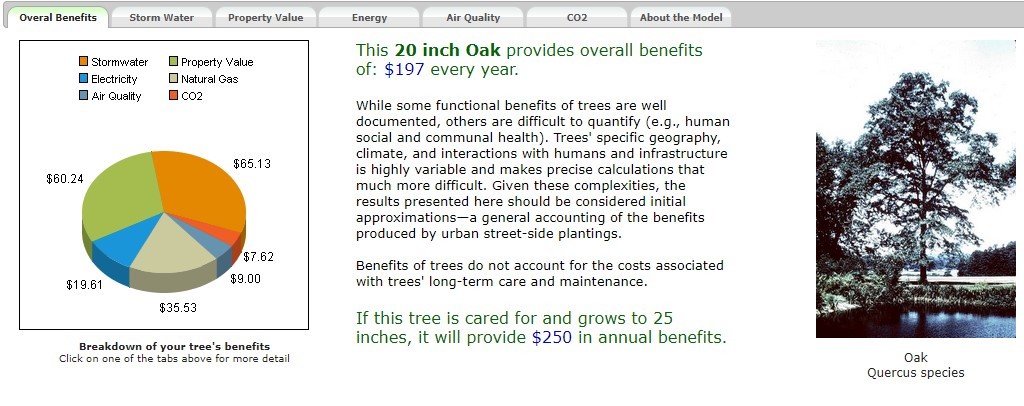 See below for more information on celebrating our biggest champion trees, calculating the benefits of trees, planting trees for a changing climate, and protecting mature trees.
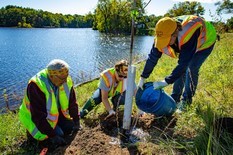
Hennepin County has healthy tree canopy grants available for tree plantings, ash tree removals, tree inventories, outreach and more. Grants are available to cities, affordable housing properties, schools, and nonprofit organizations.
The grants aim to combat threats to trees from invasive insects and disease, educate the public on tree care and the importance of trees, and increase the diversity and resiliency of the tree canopy.
Applications are due by 3 p.m. on Thursday, June 10. Learn more and apply.
For more information, feedback on your project ideas, or help with your application, contact the Hennepin County forestry team at trees@hennepin.us.
|
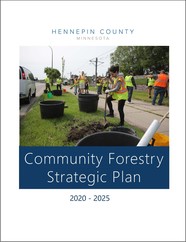
The Hennepin County Community Forestry Strategic Plan (PDF) is now available. The plan defines goals and objectives that the county’s forestry program will pursue in the next five years to protect the county’s tree canopy and increase the benefits that trees provide.
The plan includes more than 50 strategies to achieve the following goals:
- Plant, diversify, and maintain trees throughout Hennepin County
- Increase the resiliency of Hennepin County’s community forest
- Build organizational capacity to support, value, and maintain trees
- Educate and engage residents to become stewards of the community forest
Together, the strategies outlined in this plan will build stronger internal and external partnerships, get more people involved in caring for trees, and increase awareness of the values of trees. They will also establish effective forestry policies, better prepare communities for current and future threats to trees, ensure trees are used to reduce disparities and respond to climate change, and capture success stories that inspire further action. Pursuing all these strategies over the next five years will create a healthier and more resilient community forest and ensure more equitable opportunities for communities to experience the benefits that trees provide.
|
Developing the plan
The strategic plan was developed using a participatory planning process that incorporated feedback from both internal and external partners.
Through a series of workshops, county staff developed a vision for the future of the forestry program, recognized potential barriers, identified strategies, and drafted goals.
A meeting with external partners was held to gather feedback on the draft goals and strategies. The meeting had 40 participants representing forestry and public works programs in Hennepin County cities, past recipients of Heathy Tree Canopy grants, state and regional governmental agencies involved in natural resource management, the University of Minnesota, and local nonprofits involved in green space management and education. Key insights from those meetings were incorporated into the plan.
Implementing the plan and pursuing partnerships
Hennepin County foresters are beginning to implement strategies identified in the plan as they carry out their 2021 work plan. The plan will be submitted to the Hennepin County Board of Commissioners for formal adoption along with the updated Natural Resources Strategic Plan next year.
Hennepin County foresters are interested in discussing partnership opportunities that help meet the goals of the strategic plan or hearing any additional ideas you have. Connect with them by emailing trees@hennepin.us.
This spring, Hennepin County sold over 2,000 seedling trees to property owners to restore and improve woodland areas and increase wildlife habitat.
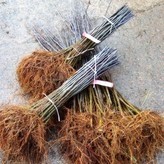
Bareroot trees ranged in size from 6 inches to 2 feet tall. Those who purchased trees indicated that they will be used for a variety of purposes, including:
- Carbon sequestration
- Habitat for songbirds, deer, turkey, grouse, and pheasants
- Reforestation
- Shade
- Slope stabilization and to improve soil health
- Visual screening
We plan to offer another tree sale in spring 2022.
|
A champion tree is the biggest documented living tree of a species in a certain area. There are several Minnesota champion trees already documented in Hennepin County: American elm, box elder, eastern hemlock, red elm, red mulberry, and sugar maple.
Every year, these champion trees together capture enough carbon to offset the annual energy use of one home. To capture the same amount of carbon that these big, mature trees do, you would need to plant 126 seedlings and let them grow for 10 years!
Do you know a champion?
It’s possible that you have a Minnesota champion tree in your yard or neighborhood that hasn’t been reported to the Big Tree Champions database.
To figure it out:
1. Measure the tree
Watch this short video from Minnesota DNR for tips on how to measure your potential champion tree.
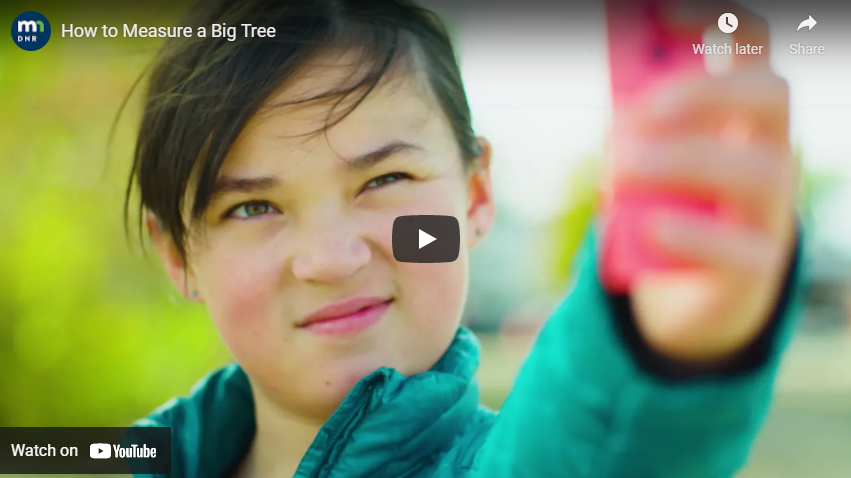
2. Check to see how the tree compares
Check your measurements against the current champion trees for your tree’s species and see if it beats out the current champion.
3. Nominate the tree
If your tree seems to measure up and might be the reigning champion, nominate it using this form (PDF).
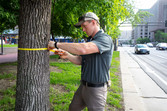
Then, measure the tree by wrapping a measuring tape or string around the tree about 4.5 feet off the ground (about chest height) to get the circumference. Divide the circumference by 3.14 to get the diameter.
|
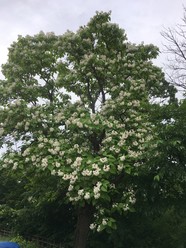
Minnesota’s changing climate is affecting what trees will thrive in our area. Planting a diversity of trees will make our communities more resilient to climate change. Learn more about trees and a changing climate from the Minnesota DNR (PDF).
As the climate in Minnesota shifts, it is important to plant trees that will thrive in the future. Consider trees of the following species for planting in Hennepin County:
- Bur oak
- Dutch elm resistant elm varieties
- Ginkgo
- Horse chestnut
- Kentucky coffeetree
- Northern catalpa
- Ohio buckeye
- Shagbark hickory
- Swamp white oak
- Turkish hazelnut
- Yellowwood
Be sure to plant the right tree for your planting location. Consider the mature height and spread of a tree when making your choice.
|
Be aware of root zones when installing or expanding patios, decks, sidewalks, and driveways

Planning to install a patio, deck, sidewalk, or expand a driveway? Be aware of the root zones of mature trees. Remember that the roots keep your beautiful mature tree healthy and hydrated. Plan your project around the roots of the trees and avoid cutting into or paving over roots whenever possible.
|
Protect mature trees during construction projects
If you have a construction project coming up, incorporate protecting mature trees as part of the planning process rather than cutting them down.
Treat some species of trees to keep them healthy
Tree Trek with the Boys and Girls Clubs of the Twin Cities

Staff from Voyageur, Hennepin County, and the University of Minnesota partnered to create the Tree Trek nature trail. Educational posts throughout the self-guided trail highlight nature facts. They also have QR codes to access even more information online. View a close-up of one of the sign posts (PDF).
|
Tree Trek online
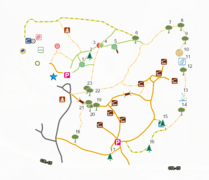
In addition to walking the trail at Voyageur, Tree Trek resources are available online with an interactive GIS story map and a series of videos:
|
Resources for raising awareness about emerald ash borer and managing ash trees
Emerald ash borer is the biggest current threat to our tree canopy. There are over 1 million ash trees in Hennepin County, and 100 percent of them are threatened by emerald ash borer. May and June are a good time to raise awareness about the threat emerald ash borer poses to our tree canopy because it's the best time to treat mature ash trees that are worth saving.
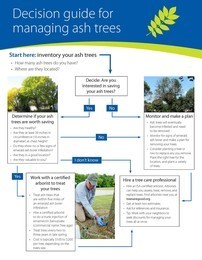
The following resources are available to help you spread the word about emerald ash borer and managing ash trees:
|
|